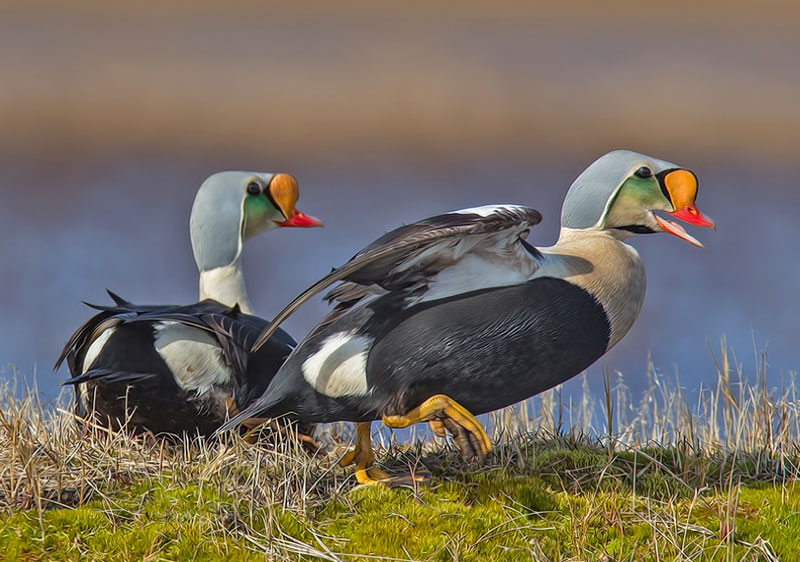The King Eider is an uncommon, hefty duck of cold, marine environments. This Arctic bird breeds about as far north as any bird species can nest in northern Alaska, Canada, Greenland, and northern Russia.
This handsome sea duck spends the winter in coastal waters near the southern extent of sea ice in the Bering Sea, eastern Russia, Scandinavia, Iceland, southern Greenland, eastern Canada, and the northeastern USA.
Males have a blocky-shaped, pale gray and orange head, stout pink bill, and black and white body with a creamy wash on the breast. Females are mostly mottled with rich reddish-brown plumage.
On this page
Identification
The King Eider is a fairly large sea duck with a rather short, stout, pink bill. The male has a square-shaped, ornate head with a pale gray crown and nape, large black eye, rounded orange front bordered with black, a bit of black on the throat, and white cheeks with a greenish wash.
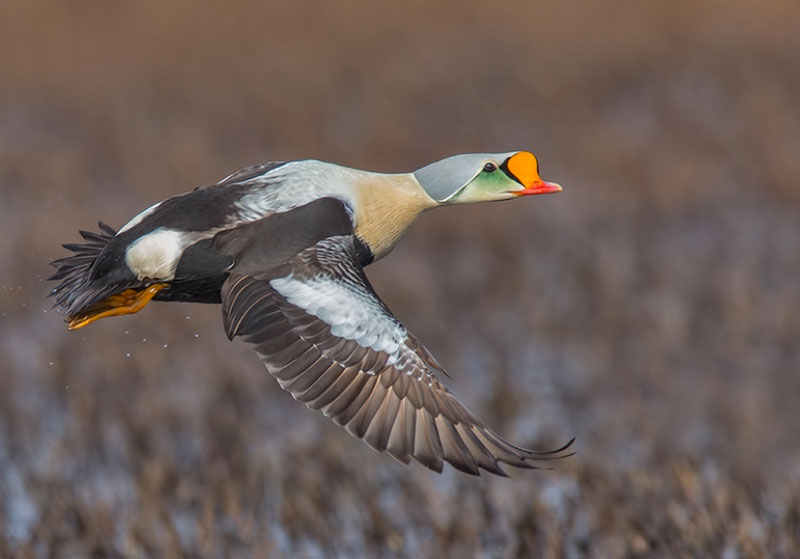
Male King Eider
It has white on the back and lower flanks, a pale, creamy breast, and black belly, lower back, sides, and tail. The long, pointed wings are black with a white patch on the front part of the wing, and some white underneath.
The female King Eider looks very different from the male and is much plainer. Her head is much less square-shaped than the male, and she has a black bill. The female has rich, reddish-brown plumage mottled with black spots and chevrons, a bit of white on the underwing, and two narrow white wing bars visible in flight.
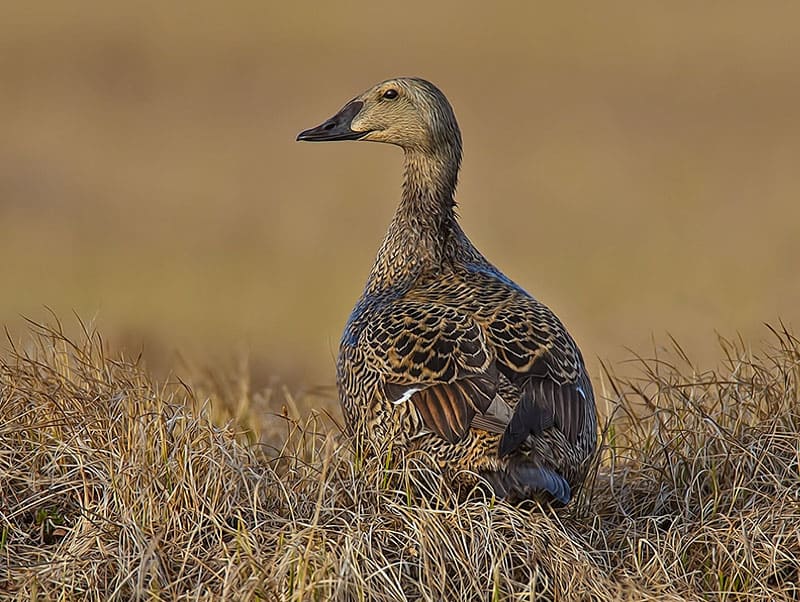
Female King Eider
Young male King Eiders look rather like a blend of male and female adults. They have pink or orange on the bill, a pale breast, and a dark back.
The King Eider uses its long wings for fast, direct flight low over the water. In flight, the male looks like a hefty black and white bird with a large orange spot on the head, and the female looks like a stout, reddish brown duck with white under the wing and two narrow wing bars.
The male of this species makes low hooting sounds during courtship; “Hoo,Hoo, Hoowoowoowoowoo“.
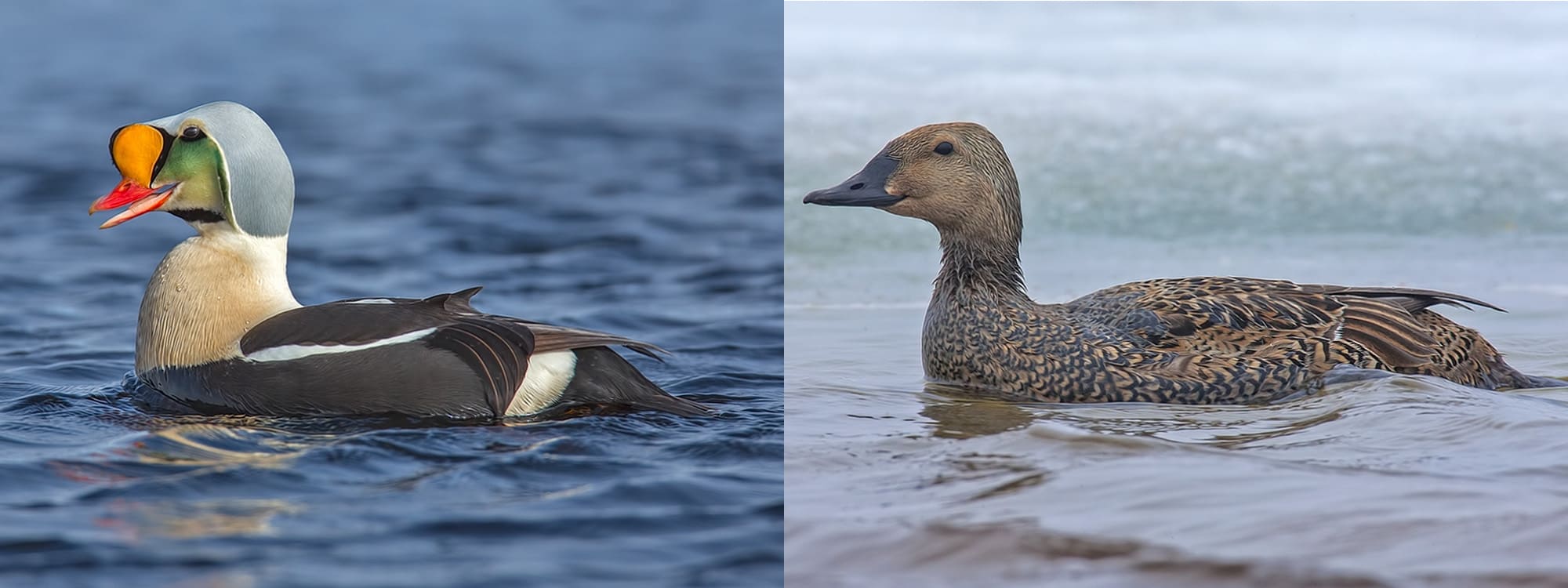
Male on the left, female on the right. Photograph © Alan Wilson.
Food of King Eider
The King Eider has a varied diet of vegetable matter and invertebrates. On its high Arctic breeding grounds, this beautiful duck uses its bill to skim the water and reaches below the surface to forage for insect larvae, small bugs, snails, and other small creatures in addition to eating sedges and other types of plants.
When breeding near deeper waters, they also dive for food such as crustaceans, caddisflies, and other small animals that live on the bottom of tundra ponds.
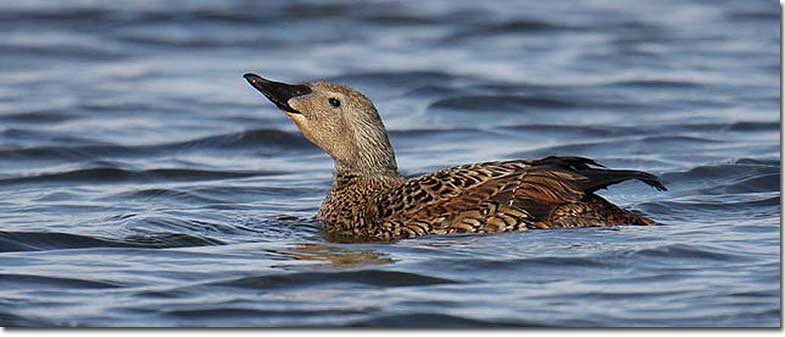
King Eider (female)
During migration and the winter, the feeding behavior of the King Eider changes to that of diving in coastal waters to pick algae, mollusks, crustaceans, crabs, sea worms, and other small creatures from the bottom of the sea, up to 60 feet below the surface.
Birds often dive together as a flock and search for food by sight in kelp beds, and over both sandy and rocky ocean bottoms. Their eyes are adapted to marine conditions and food is usually eaten under the water.
Nesting and Eggs
In mid-June, King Eider pairs fly over the tundra in search of a suitable place for nesting. When they find a good spot, the female walks around and investigates, placing her body on the ground until she finds the perfect site. She moves the vegetation with her body and bill to make a shallow scrape.
After the first egg is laid there, she arranges nearby tundra grasses and vegetation in and around the egg. After the third or fourth egg is laid, she places down feathers in the nest. The male doesn’t help with any of the nest building but stays nearby when the first eggs are laid to help guard the nest, or to at least warn the female of predators.
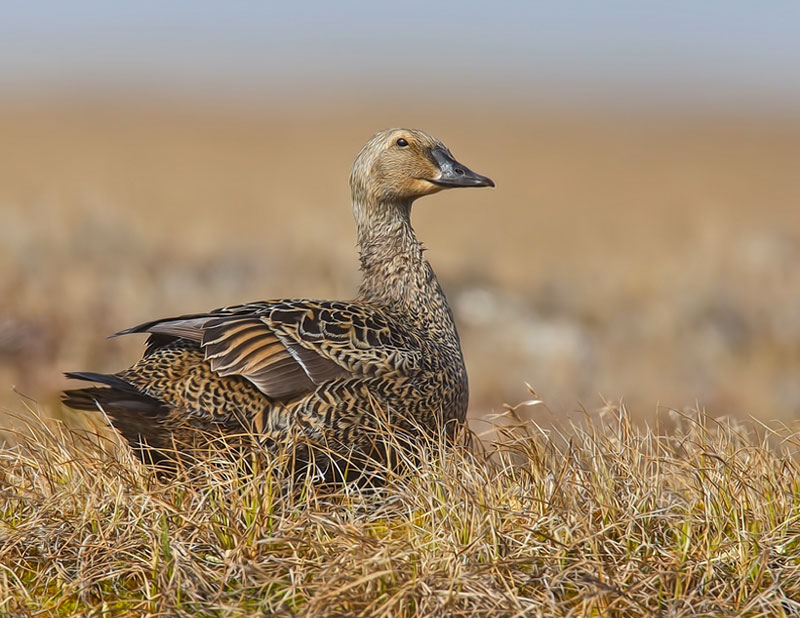
Anywhere from one to 17 eggs can be laid although 7 eggs are the average. Nest sites can be located on small islands, near water, or in drier areas some ways from water. The eggs are incubated by the female for three weeks, are pale olive, and weigh around 65 grams.
While she is on the nest, the female is very alert and always watching for potential predators. If a fox or other possible predator is nearby, she crouches down low and extends her neck on the ground to try and be concealed by and blend in with the surrounding vegetation.
After hatching, nestlings are brooded for seven hours. Shortly after, they leave the nest and follow their mother for up to 50 days, all the while, moving steadily closer to the sea. The young birds feed on their own in small tundra ponds and escape predators by diving under the water.
Similar Species
The male King Eider is pretty easy to recognize but there are a few similar species. Females can be more of a challenge but given a good look, they can also be readily identified.
- The male Common Eider has similar black and white plumage but has a white back that meets the white on the shoulder of the wing. It also lacks the orange front of the King Eider, has a black cap, and, compared to the blocky head of the King Eider, has more of an elongated, triangular-shaped head.
- The male Spectacled Eider of the Bering Sea is also similar to the male King Eider but has a black breast and a greenish head with a large white circle around the eye.
- Female Spectacled and Common Eiders look very much like the female King Eider. Compared to those and other duck species, the female King Eider has a rather blocky or square-shaped head, a stubbier, black bill, and lacks the pale area around the eye of the female Spectacled Eider.
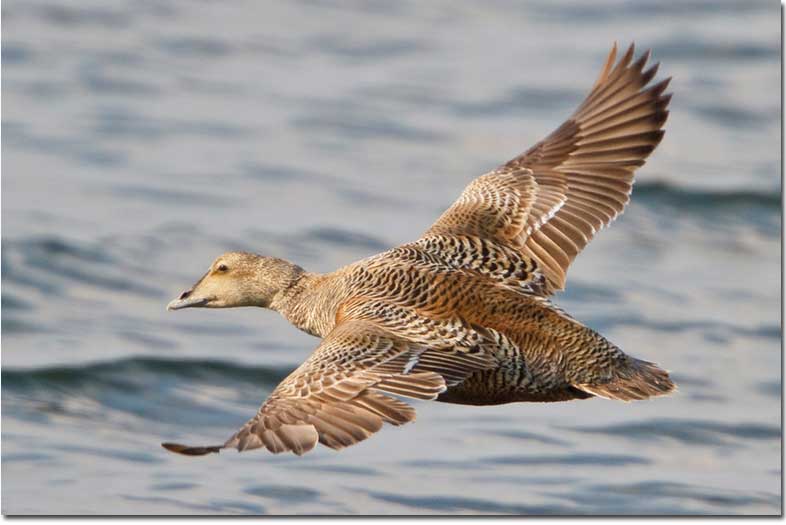
Common Eider – Photograph © Glenn Bartley
Current King Eider Situation
The King Eider breeds in high Arctic tundra in northern Alaska, northern Canada, Greenland, and northern Russia. Birds that breed in North America either migrate to the Bering Sea, or to coastal waters of the Atlantic Ocean in eastern Canada and the northeastern USA.
Populations from Russia winter in coastal waters of northern Scandinavia and eastern Russia. Once in a while, a few eiders migrate to Lake Ontario or south to Florida but this a rare occurrence that usually involves inexperienced, juvenile male birds.
This sea duck is fairly common on its remote Arctic breeding grounds and in established coastal wintering areas. Although it is often considered to be rare, this stems from the fact that the species mostly lives in remote, inaccessible, and little visited areas.
The King Eider is not endangered and still has a large population but due to ongoing declines in Canada, Alaska, and other parts of its range, it is a species of concern. The reasons for these ongoing declines are unknown but may be related to oil spills and the effects of climate change.
Facts
- Along with some other sea duck species, the King Eider has bone structures around the eyes that protect it from rocks, sand, vegetation, and prey items while foraging on the bottom of the sea.
- This species often selects nesting sites in areas with large numbers of lemmings. This may reduce predation by Arctic Foxes because such areas tend to also be used by jaegers and Snowy Owls; two aggressive bird species that routinely harass and chase away foxes.
- Perhaps because they are so vulnerable, female King Eiders are very nervous at their nest sites and may abandon nests if a plane flies too close, or if people walk nearby or handle the eggs.
- Very few duckling King Eiders make it to adulthood. Studies have shown that a high number of broods are lost within 2 days of hatching, and only 10% of ducklings lived for more than two weeks. The small ducks are caught by Arctic Fox, falcon-like Jaegers, and the huge Glaucous Gull. These losses are probably offset by adults having few predators and a lifespan of 15 to 20 years.
FAQ
Where do King Eiders live?
King Eiders live in the Arctic tundra during the summer and spend the winter in cold coastal waters of the Bering Sea, eastern Canada, the northeastern USA, Scandinavia, and eastern Russia.
How big is a King Eider?
A King Eider is around the same size as a Mallard duck.
Where can I see King Eiders?
King Eiders can be seen in coastal waters of Alaska, especially during migration, and in coastal waters off of eastern Canada and Maine south to New Jersey.
What are the characteristics of a King Eider duck?
The King Eider is a hefty sea duck that dives in cold coastal waters for mollusks, crabs, and other small sea creatures. The male has a large orange mark on the head and black and white plumage, and the female is reddish brown with a short black bill.

